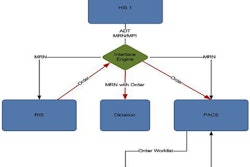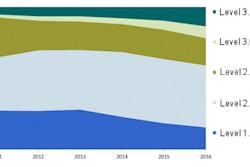Although technically and financially challenging, making a patient's radiology images and records accessible to any physician who needs them is intrinsic to the concept of digital radiology. In Australia, the state of New South Wales is making this happen.
An enterprise imaging repository (EIR) passed its proof-of-functionality pilot project in three health districts in June and is currently being rolled out in the other 13 health districts. The hope is that when funds become available, every state in Australia will eventually have similar health information and imaging exchanges that can also communicate with each other, effectively wiring the country from a health IT perspective.
AuntMinnie.com talked with program manager Joe Hughes about how a business case originally approved in 2007 finally became a reality.
Population dynamics
On a square mile basis, Australia is one of the least populated countries in the world. However, about 14.5 million people -- two-thirds of the population -- are concentrated in eight major cities. New South Wales is Australia's most populous state, contributing 32% of Australia's population. Among its 7.3 million residents, 63% live in the metro Sydney area.
Healthcare in Australia is provided by the federal and state governments, accounting for 27% of total government spending. Each day, $50 million ($52.1 million U.S.) is spent on healthcare out of an annual budget of $18.3 billion ($19.1 billion U.S.).
In New South Wales, the population is aging and a steadily increasing percentage is developing complex and chronic diseases. Its Health Support Services department is under financial pressure to improve efficiency, quality of care, safety, and patient outcomes.
Years ago, the state government began to invest in healthcare IT infrastructures. One of the first full hospital PACS in the world was installed at Sydney's Royal Alexandra Hospital for Children, now the Children's Hospital at Westmead, in the early 1990's.
This first experience was a positive one. Over the past two decades, large investments have been made in electronic medical record (EMR) systems, RIS, and PACS. Today, the state has eight EMRs from two vendors, nine RIS/PACS from four vendors, and nine PACS from two additional vendors.
The project
The initiative to develop the repository for New South Wales evolved from a longstanding commitment to use IT to improve healthcare. A business case was approved in 2007, but it was tabled due to cost. The project requirements were redesigned and a new tender was released in 2009 and 2010.
A bid from Japanese IT firm Fujitsu and partner TeraMedica was accepted in late 2010. As prime contractor and systems integrator, Fujitsu needed to seamlessly connect nearly 100 clinical facilities, each using their own patient identifiers, EMR systems, RIS, PACS, and archives. The enterprise image repository (Evercore, TeraMedica) would need to natively manage and distribute DICOM images and other clinical content such as treatment plans for cancer care.
In addition to providing universal access to clinical images, project goals were to improve the timeliness of clinical decision-making, reduce the number of repeat diagnostic imaging procedures, and increase the efficiency of transporting patients between hospitals.
The program was launched with a pilot involving the Western Sydney and Nepean Blue Mountains health districts and Children's Hospital at Westmead, which is considered a health district for pediatric patients. This involved seven hospitals and clinics that together performed approximately 300,000 radiology exams a year; the children's hospital performs approximately 100,000 exams annually.
These districts were selected because they were in close geographic proximity. The children's hospital was selected because it had a high rate of patients being transferred to it. The state program team also had a strong relationship with the radiologists and the chief information officers at the hospitals.
Collectively, the hospitals had two different versions of EMRs (Cerner), two RIS/PACS vendors (GE Healthcare and Siemens Healthcare), and two PACS vendors (Cerner and iSoft). With this diversity, the pilot project would have to demonstrate the ability to seamlessly interchange data and resolve any issues within this diverse environment, Hughes said.
This was critical because additional vendors would be connected when the other districts were added, as well as different software versions of the RIS and PACS, he said.
Implementation
The project began with implementation of an enterprise patient registry and an individual health identifier in December 2011, followed by the imaging repository in February. The 60-day pilot period followed, with clinical and technical evaluations taking place in May. Rollout to the remaining 13 districts in the state was approved in late June.
The statewide master patient index manages individual health identifiers. Each district has its own patient identifiers, but because patients may receive healthcare in different districts, they may have up to 10 unique numeric identities. Local health districts originate all merge and update activities. These are then propagated to the statewide master patient index and then to the image repository, Hughes explained.
The biggest challenge was integration to the RIS/PACS, which was much harder and more time consuming than expected, Hughes said.
"The EMR, RIS, and PACS vendors do not have large technical staffs in Australia; they don't need them," he said. "But once the project got under way, it was necessary for every vendor involved to reach out to their development engineers and software specialists throughout the world to enlist their expertise. Many people took trips to Australia that they hadn't planned or budgeted for. In retrospect, while we and the vendor community realized that there would need to be configuration changes in the systems, the assumption tended to be made that they would be 'typical' IT configuration changes. This wasn't so."
The complexity of the project also resulted in more project managers and technical staff being assigned to the project than had been budgeted, Hughes said.
"I think this also was the case for vendors," he said. "Through a lot of hard work and problem-solving experiences, which I think can be of benefit to other projects like ours, we succeeded," Hughes said.
Acceptance and use
To the relief and delight of everyone involved, the pilot launched with a high level of interest and acceptance. From the time the pilot began in March through the end of June, clinicians accessed images via their EMR almost 23,000 times. (The repository has three methods of access: by PACS, by a direct login to the EIR, and through the EMR via a link.)
Twenty physicians directly accessed the EIR 433 times. Radiologists accessed the repository from their PACS, transferring 33,188 images from the EIR into their PACS.
The most delighted users are clinicians, Hughes said. Many who access the system through their EMR are also sharing the images with patients as they explain the details of the radiology reports.
"This is a huge win for patients and clinicians," Hughes said. "If doctors are getting benefits, patients are getting benefits."
Another successful application has been telephone consultation among clinicians simultaneously viewing a patient's images and electronic medical record. It's been especially helpful when trying to determine whether a patient needs to be transferred to another hospital for more specialized care.
Another frequent and vital use is the immediate review of emergency exams performed by an admitting hospital for a patient who is in transit to a specialist hospital. The staff at the receiving hospital can have near instant access to review the patient's records and diagnostic images, preparing them to start treatment immediately, Hughes said.
Another use is remote consultation by a specialist with a physician and a patient. Many trips to specialists have been avoided, saving time for the patient and reducing healthcare costs, according to Hughes.
"As the EIR is used, it is discussed; when discussed, it is used even more," Hughes said. "Clinicians outside the currently 'wired' districts are clamoring to get on board."
The rollout won't take place in a day or even a month. Approximately 25% of the hospitals in New South Wales don't have a RIS or a PACS. These are being installed under the program management of Hughes and his expanded staff. He ended up needing to hire a full-time integration manager, an image repository manager, a change coordinator, and customer support staff, a total of six to date. A core of about six additional IT staff report to Hughes, who spends about half of his time on the project.
"Australia maintains a low profile when it comes to healthcare IT, but we're a very innovative country," he said. "Now, in addition to being able to say that we had the first children's hospital PACS in the world, we think we now have the most complex EIR. And we expect to be among the first in the world to tangibly demonstrate just what benefits this can provide to our citizens and to our governments paying for our healthcare."



















